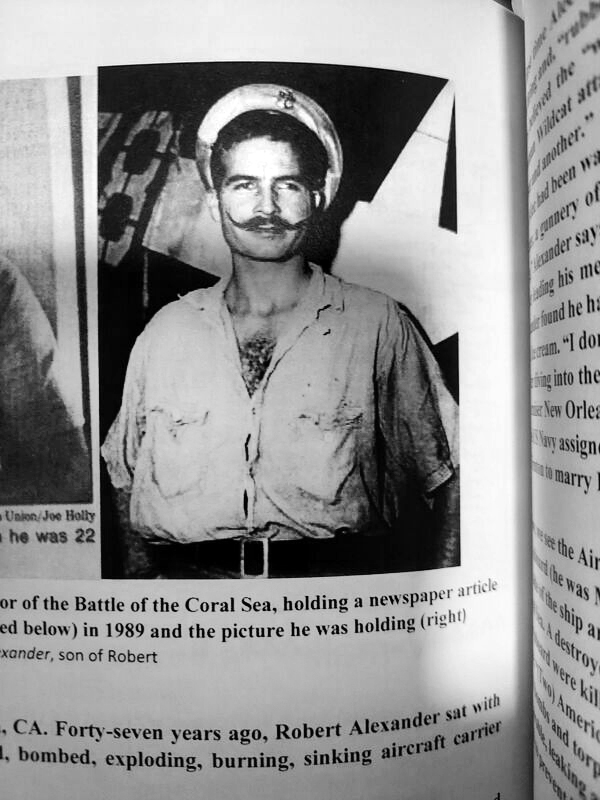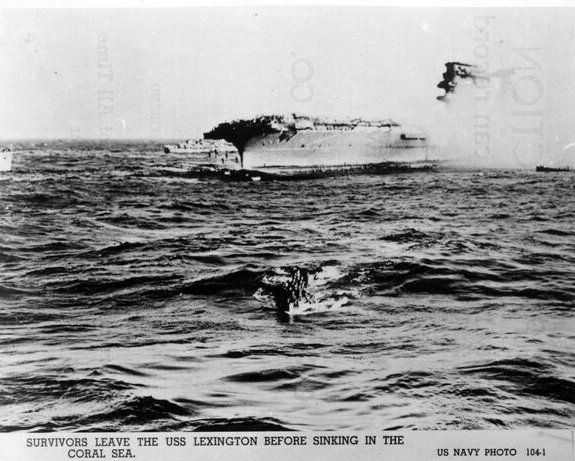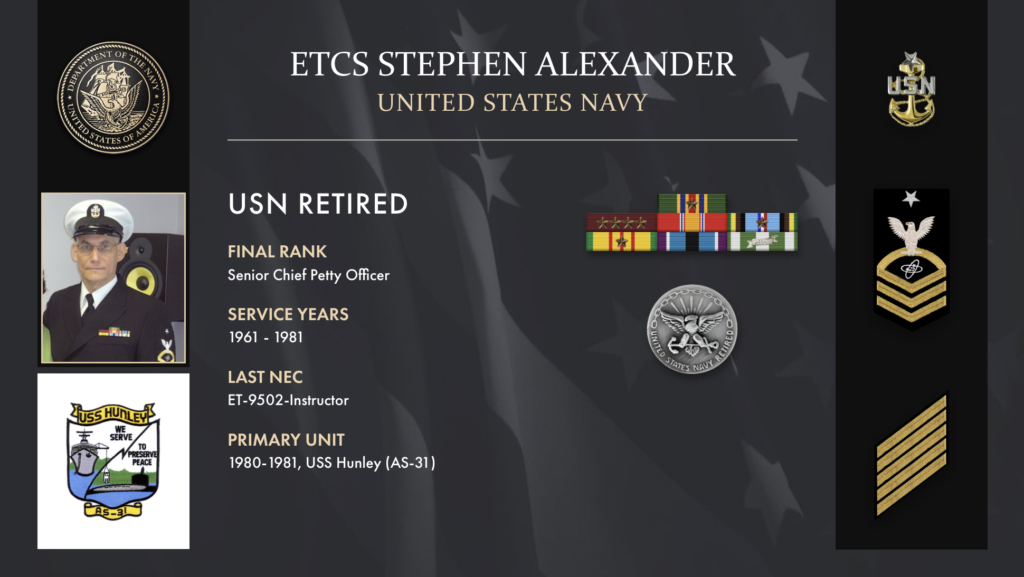PRESERVING A MILITARY LEGACY FOR FUTURE GENERATIONS
The following Reflection represents ETCS Stephen Alexander’s legacy of their military service from 1961 to 1981. If you are a Veteran, consider preserving a record of your own military service, including your memories and photographs, on Togetherweserved.com (TWS), the leading archive of living military history. The Service Reflections is an easy-to-complete self-interview, located on your TWS Military Service Page, which enables you to remember key people and events from your military service and the impact they made on your life.
Did Any of Your Parents or Grandparents Serve? What Facts or Stories Do You Remember About Their Service?
My oldest brother, Robert C. Alexander, served aboard the USS Lexington (CV-2) during WW2 and was aboard during her final battle in the Coral Sea. He was an MM1 at that time and was assigned to a damage control party deep in the ship, near the stern. He wrote a letter outlining the battle’s events as he experienced it from his battle station. I will copy that letter here so he can tell his story in his own words.
Dear Russ
I A W your telco request for February 18th. Please submit the following. You may do with it whatever you see fit.
It was my biggest thrill in over thirty years of naval service. If there is a moral to be found, it would be ‘OBEY. ‘
This story unfolds on board the USS Lexington CV2 on May 8th, as this, the largest and fastest aircraft carrier in the U.S. Navy, was cruising the South Pacific in company with a Task Force in the midst of what is now known as the Battle of the Coral Sea. As a sea tale, the story is not concerned with the events or results of that battle. The theme is contained in one word: OBEY, and the consequences of not doing so.
The crew is at General Quarters, or to a civilian battle stations. A vigorous air attack by the Japanese had been centered on the Lexington with mixed results. Damages had been sustained in the forward and midsection on the port side from bombs and torpedoes, but the ship had been leveled by counter flooding and was proceeding at 25 knots retrieving her own planes returning from a similar attack on the enemy task force.
We open this story in a compartment, deep in the bowels of the ship at the stern:
Long 155 -27‘ East May 8th May 1st 8thatitude 15 -12’ South
Above our heads, the noise of the scuttle slamming into open position was still reverberating throughout the small engineering space when our Chief (NOTE 1) lowered himself through the small circular hole in the dogged-down horizontal hatch onto the ladder leading from the deck above down to the deck we occupied, balanced himself in a bent-over posture, and quickly descended into our midst.

We are in trouble. Bad trouble! He announced.
There was no need for him to ask for our attention. He had it. The utter, deep silence that occupied this space had created fear in some and bewilderment in all since he had left us over an hour ago to explore the unknown and find out what was happening.
More than a dozen of us had assembled here in the early pre-dawn hours this morning in answer to the call Battle Stations! and it was now afternoon. We were a cadre of repairmen and machine operators cached in a secluded space deep inside the Lexington that contained sound-powered telephone communications to the other nerve centers throughout the ship. Our mission was to await any call for assistance to repair or control damage to the ship or to operate any machinery needed if the regular battle operator were killed.
This foreboding silence is novel. Earlier this morning, as we manned our telephone sets and reported, Ready on Station, this was not so. Then, we could hear and feel the rudder shift from port to starboard as Lex maneuvered. We could hear and feel all the screws slicing and digging through the Coral Sea. We could hear and feel the 5″ anti-aircraft batteries firing. We could feel the torpedoes hitting us and the bombs hitting and imagine the sound of the one-point-ones and smaller caliber A/A shooting at our Japanese attackers. But that was hours ago. It has been deathly quiet for a long time now. Not even the telephones have talkers at their other ends.
The Chief continued speaking. The crew is abandoning the ship. There is fire in all the spaces surrounding us here. We must get out of here quickly. Together! I do mean together. DO NOT GET SEPARATED. Hold on to each other at all times. Alexander knows the way we’ll go, so he’ll go first, and I will bring up the rear. We will muster on the port quarter of the flight deck as soon as we get there. Alexander, as soon as we are all out of the last scuttle, I want you to cross the fuselage deck to starboard, ascend the ladder to the torpedo mezzanine deck, go aft through the torpedoes into the torpedo workshop, through the starboard quarter living space, into the parachute rigging loft athwart ship to port, up to the main deck, out on to the port gun sponson and up to the flight deck. The torpedo workshop is on fire, but you’ve got to go through it. There is no other way! Now go!
As soon as I emerged from the last scuttle, I set aside the heavy battle lantern I had brought along. It was so dark with smoke that I couldn’t see the deck with the light six inches from it anyway. Someone had a tight grip on my belt from behind and was nudging me onward. I took one step forward and then dragged myself back one-half. It was hot, fiery, and dark. Scary!
The Chief knew you could do this in the dark, so do it! Don’t lose your courage. Keep going and stay calm.
We wormed and pulled and surged our way across the width of the fuselage deck to starboard in total darkness. When someone fell, we waited.
Here’s the ladder. Up we go. It is very steep with a chain on each side for handholds. I have to hold on to the chains very tightly to prevent the guys on my back belt from dragging me off. When I feel he s ready to proceed, I try but he s not. It’s getting hotter as we ascend. The chains are hotter. Now, I am trying to relieve my hands from the pain of clinging onto the hot chains at every pause in our jerky, tugging journey up. I loop my arms around the chains to hold my position on the ladder while the men surge below. But, to move on, I must again grasp the chains with both hands. I dare not fall. If I fall, we all go down.
I’m up. My hands are burned, and they hurt. My forearms are burned, and they hurt. That ladder is hot. So are these fish! I put my hands on several torpedoes, armed and ready for aircraft loading. They are hot, too hot to touch. I know we are in the midst of nine of them on their ready racks, ready to go, because I had just charged them with high-pressure air this morning. How hot can TNT get before it blows prematurely?
The next guy is up. And the next. This mezzanine deck is just under the flight deck and extends forward from here to the torpedo elevator, where the torpedoes are elevated to the flight deck. From here aft it leads to the torpedo workshop. We start aft. (NOTE 2)
The torpedo workshop door is dogged closed. I undog and open it. Yes, we are going in there! The Chief said so.
We bumped and jostled our way through the workshop to the after door. Dogged again! I undogged and opened it. Hurray! No fire! We have made it clear sailing now.

Through the living space aft, athwart ship to port through the parachute rigging loft, up to the main deck, to the port gun sponson, and up to the flight deck! What a thrill to see the sun again. It looks like we all made it together, too.
The Chief is grinning. We’re all grinning. He finishes his muster. Where’s Willie? Where’s Krause? Thirdman? he frowns and glances around the flight deck area. Stay put. I’ll be back, he ordered, and disappeared. There were men all over the flight deck area, preparing to leave the ship. Ropes and lines hung from the stern down to the water’s edge for climbing. Airdales were stripping inflatable life rafts from aircraft on deck and tossing them inflated over the side.
Go down the lines. Don’t jump! You’ll kill someone! Someone bellowed.It’s easy to see why. The water was as full of men as a public beach would be on the Friday, July 4th, Alexander. Put your hands in this; maybe it’s got butter in it. Your hands look like hell! The Chief is back and has an inverted steel battle helmet full of melting ice cream he has salvaged from the gheedunk stand just below the flight deck.
He sat the helmet between my legs on the flight deck, and I gratefully immersed my burned hands in the cool goop.
I didn’t see Willie or Krause. Someone thinks he saw Thirdman. I have Repair III patrols searching the after-hanger deck area just in case. The Chief paused, then continued, “I’ll look some more.” He left to continue the search.
NOTE 1. The Chief was Louis Giegerich CMM President #11, 1966-1967 of our Lexington Club. He saved our lives, and it was part of his job.
NOTE 2. At this point, all men had ascended the ladder. The Chief remained on the fuselage deck to search for others in need of help.
Many, many years passed, and at our Annual Muster in San Diego, at the Mission Bay Hilton (when Joe E. Brown was our speaker), I saw ‘Thirdman’ again. He was out from —– for his first reunion and related the following to me.
I choose to conceal his true name. [And where he is from.] Thirdman was not going to follow me and my charge into the torpedo workshop. He knew a better way. He broke off our chain line going aft and proceeded forward on the torpedo mezzanine deck, taking Krause and Willie Thau with him. He was going to go forward to the torpedo elevator and exit straight up to the flight deck level and safety. Much closer and quicker.
However, when the trio reached the elevator area, they could NOT get out and so had to retrace their steps back to the ladder. All three fell down the ladder back onto the fuselage deck. A repair party patrol found Thirdman and rescued him. Willie Thau [Willard A. Thau MM1c, A division] and Krause [John H. Krause, F1c] were never seen again.
In my judgment, all three would have survived had Thirdman followed the Chief’s orders as the rest of us did.
This account is the written record of Robert Claude Alexander, Lieutenant Commander, United States Navy, who at the time of the incident was a Machinist’s Mate First Class, in A Division.

Read the Military Memories of our Runner-Ups.
PRESERVE YOUR OWN SERVICE MEMORIES!
Boot Camp, Units, Combat Operations
Join Togetherweserved.com to Create a Legacy of Your Service
U.S. Marine Corps, U.S. Navy, U.S. Air Force, U.S. Army, U.S. Coast Guard
0 Comments